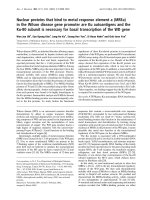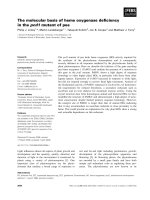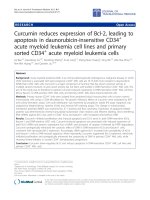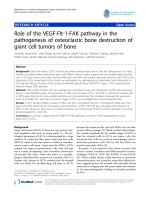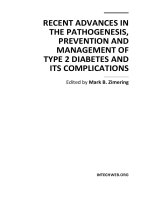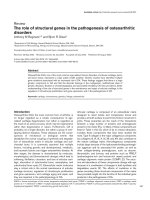Role of misfolded nuclear receptor co repressor (n cor) induced transcriptional de regulation in the pathogenesis of acute monocytic leukemia (AML m5
Bạn đang xem bản rút gọn của tài liệu. Xem và tải ngay bản đầy đủ của tài liệu tại đây (16.19 MB, 227 trang )
ROLE OF MISFOLDED - NUCLEAR RECEPTOR
CO-REPRESSOR (N-CoR) INDUCED
TRANSCRIPTIONAL DE-REGULATION IN THE
PATHOGENESIS OF ACUTE MONOCYTIC
LEUKEMIA (AML-M5).
NIN SIJIN DAWN
(B.Sc., NUS)
A THESIS SUBMITTED
FOR THE DEGREE OF DOCTOR OF
PHILOSOPHY
DEPARTMENT OF MEDICINE
YONG LOO LIN SCHOOL OF MEDICINE
NATIONAL UNIVERSITY OF SINGAPORE
2011
ACKNOWLEDGEMENTS
The past four years had been an enriching and fruitful journey of both
scientific and self discovery. I would like to take this opportunity to express
my deepest gratitude to the many people who have made this possible.
! First of all, I would like to thank my supervisor, Dr Matiullah Khan,
for providing me with the opportunity to embark on this journey. Heartfelt
thanks for all the mentorship, support and encouragement throughout these
years. Thank you for giving me the opportunity to express myself and to
defend my ideas.
I would also like to extend my sincere gratitude to our many
collaborators, Dr Koichi Okumura for his invaluable input on some of the
work done in this thesis and for taking the time to vet my thesis; A/Prof Chng
Wee Joo and Prof Norio Asou for their kind assistance with the patient
samples and A/Prof Motomi Osato for his assistance with the mouse work. My
deepest appreciation also goes to A/Prof Motomi Osato and A/Prof Prakash
Hande for kindly agreeing to be members of my Thesis Advisory Committee
as well as to Dr Deng Lih Wen for the help she had rendered during the
Graduate Studies application process.
I am also immensely grateful to Dr Azhar bin Ali for his guidance and
advice about life and research. I truly enjoyed the intellectually stimulating
conversations we had in the mornings.
My heartfelt thanks to my wonderful lab mates past and present,
Angela, Jek, Chai Peng, Hannah, Norlizan, Angie, Li Feng, Leo, Wai Kay, Su
Yin, Jayne, Jess, Fen Yee, Wanqiu, Yan Kun and Meg for their
companionship and assistance during the long hours spent in the lab. It has
been a real pleasure working with all of you. Special thanks to Li Feng and
Wai Kay for their assistance and advice on the Flt3 project.
I was also fortunate to have had received assistance from the staff from
the NUMI Core FACS facility. I am grateful for the wonderful help and
expertise rendered by Kok Tee and Ling Yao.
Many thanks to the wonderful people I have met along the way, Bee
Keow, Mei Xian, Sandy, Tada-San, Judy, Tomoko, Joan, Li Ren, and many
more. Thank you for the friendship. Life in the lab will not be the same
without you guys.
Finally, I would like to express my most sincere thanks to my family. I
feel truly blessed to have a strong and supportive family network. Thank you
for the encouragement, understanding and tolerance shown to me during this
journey.
Thank you.
Nin Sijin Dawn
September 2011
TABLE OF CONTENTS
SUMMARY
i
LIST OF PUBLICATIONS
iii
LIST OF TABLES
iv
LIST OF FIGURES
vi
LIST OF ABBREVIATIONS
xii
CHAPTER 1
INTRODUCTION
1. Introduction
1.1 Acute Myeloid Leukemia.
1.1.1. Acute Monoblastic/Monocytic Leukemia.
1.1.2. Current treatment strategies for AML-M5.
1
4
5
1.2 The Nuclear Receptor Co-repressor (N-CoR), a
component of the transcriptional repression
machinery and its role in AML pathogenesis.
1.2.1. The importance of the transcription machinery
in the regulation of hematopoiesis.
1.2.2. The Nuclear Receptor Co-Repressor (N-CoR)
1.2.2.1. N-CoR in normal development.
1.2.2.2. N-CoR in Carcinogenesis.
1.2.2.3. N-CoR in AML Pathogenesis.
6
6
8
11
12
12
1.3 Protein Misfolding and its role in AML
pathogenesis.
1.3.1. Protein folding and the Unfolded Protein
Response (UPR).
1.3.2. Protein Misfolding and Disease.
1.3.2.1. Protein Misfolding in Carcinogenesis
1.3.2.2. Protein Misfolding in AML.
15
15
17
18
19
1.4. Akt and its role in transcription factor mediated
carcinogenesis.
1.4.1 Akt
1.4.2. Akt activation.
1.4.3. Identification and regulation of Akt substrates
1.4.3.1. Regulation of transcription factors by Akt
22
22
23
25
25
1.5. The FMS-Like Tyrosine Kinase 3 receptor (Flt3)
1.5.1. Receptor Structure
1.5.2. Role of Flt3 in normal hematopoiesis.
1.5.3. Flt3 in leukemogenesis
27
27
29
31
1.6. Hypotheses and Aims of this project.
34
CHAPTER 2
MATERIALS AND EXPERIMENTAL
PROCEDURES
2. Materials
and
Experimental
Procedures
2.1. Materials
2.1.1. General Reagents
2.1.2. Antisera
2.1.2.1. Western Blotting (WB)
2.1.2.2. Immnofluorescence Staining (IF)
2.1.2.3 Flow Cytometry Analysis
2.1.3. Primer Sequences
2.1.3.1. RT-PCR primers
2.1.3.2. qRT- PCR Primer Assays (Taqman)
2.1.3.3. ChIP Assay Primers
2.1.3.4. siRNA sequences
2.1.3.5 Site directed mutagenesis sequences
2.1.4. Plasmids
2.1.4.1. pACT –N-CoR-Flag
2.1.4.2. pEGFP-MLL1-AF9
2.1.4.3. pECFP-myr-Akt
2.1.4.4. Luciferase reporter plasmids.
2.1.5. Cell Lines
2.1.5.1. AML-M5 cell lines
2.1.5.2. AML cell lines from other FAB subtypes
2.1.5.3. Non AML cell lines
36
36
38
38
39
40
40
40
41
42
42
42
43
43
43
43
44
44
44
44
45
2.1.6. AML primary patient specimens
45
2.2. Experimental Procedures
2.2.1. Tissue Culture and Techniques
2.2.1.1. Mammalian cell culture maintenance.
2.2.1.2. Storage of cells.
2.2.1.3 Revival of frozen cells.
2.2.1.4 Treatment of cells with Drug compounds,
Cytokines and antibodies.
2.2.1.4.1. Treatment of THP-1 cells with AEBSF.
2.2.1.4.2. Treatment of THP-1 cells with Genistein.
2.2.1.4.3. Treatment of THP-1 cells with Akti-X.
2.2.1.4.4. Treatment of THP-1 cells with Kaletra.
2.2.1.4.5. Treatment of THP-1 cells with anti-Flt3
antibody.
2.2.1.4.6. Treatment of BA/F3 cells with rm-Flt3
ligand.
2 .2.1.4.7.Treatment of HEK293T cells with rh-Flt3
ligand
2.2.1.5. Transfection of cells
2.2.1.5.1. Transfection in HEK293T cells using
Fugene 6.
2.2.1.5.2. Transfection in HEK293T cells using
Lipofectamine 2000.
2.2.1.5.3. Transfection in AML cell lines and BA/F3.
2.2.1.5.4. siRNA mediated gene knockdown.
2.2.2. Protein Assays.
2.2.2.1. Direct Lysis of cells.
46
46
46
46
47
47
47
47
48
48
48
48
49
49
49
49
50
50
51
51
2.2.2.2. In Vitro Cleavage Assay
2.2.2.3. Protein Solubility Assay
2.2.2.4. Immunoprecipitation
2.2.2.5. In Vitro Phosphorylation Assay
2.2.3. Protein expression analysis
2.2.3.1. SDS-PAGE
2.2.3.2. Western Blotting
2.2.4. Cell Based Assays
2.2.4.1. May-Grunwald-Giemsa Staining
2.2.4.2. Immnofluorescence Staining
2.2.4.3. Cell Proliferation Assay
2.2.4.4. Apoptosis Assay
2.2.4.5. Determination of Cell Differentiation
2.2.4.6. Colony Assay
2.2.4.7. Long-Term Culture-Initiating Cell (LTC-IC)
Assay
2.2.5. In vivo Transplantation Assay in Mice
2.2.6. Gene expression analysis
2.2.6.1. RT- PCR analysis
2.2.6.2. qRT- PCR analysis
2.2.7. Promoter Studies
2.2.7.1. Dual Luciferase Reporter Assay
2.2.7.2. ChIP Assay
51
52
52
53
54
54
55
56
56
56
56
57
57
58
58
58
59
59
60
63
63
64
2.2.8. Creation of N-CoR mutants.
2.2.8.1. Site Directed mutagenesis
2.2.8.2. Gel Extraction
2.2.8.3. Transformation.
2.2.8.4.%Plasmid%purification%
2.2.8.5.%Determination%of%successful%mutants.%
2.2.8.6.%Large%Scale%Plasmid%purification.%
%
66
66
67
67
68
68
69
CHAPTER 3
RESULTS
3. Results
3.1. Akt induced N-CoR Phosphorylation is linked
to its misfolded conformation dependent loss in
Acute Monocytic Leukemia (AML)-M5 subtype.
3.1.1. N-CoR is processed by an aberrant protease
activity in AML-M5 cells.
3.1.2. AML-M5 cells harbor the misfolded N-CoR
protein.
3.1.3. Misfolded N-CoR exhibits aberrant serine/
threonine phosphorylation.
3.1.4. Identification of Akt as a mediator of N-CoR
misfolding in AML-M5 cells.
3.1.5. N-CoR is a direct substrate of Akt.
3.1.6. Phosphorylation at the Serine 1450 residue by
Akt was essential for the misfolding of N-CoR
protein.
71
71
78
85
88
96
103
3.1.7. The negative charge conferred by the
phosphorylation event initiates N-CoR
misfolding in AML-M5.
3.2. Role of misfolded N-CoR mediated
transcriptional deregulation of Flt3 in the
pathogenesis of Acute Monocytic Leukemia
(AML)-M5 subtype.
3.2.1. N-CoR loss correlates with the up-regulation of
Flt3 expression.
3.2.2. Flt3 is a transcriptional target of N-CoR.
3.2.3. N-CoR loss promoted IL-3 independent growth
potential of BA/F3 cells via the up-regulation of
Flt3.
3.2.4. N-CoR loss was potentiated by Flt3 signaling
activation.
3.2.5. A potential tumor suppressive role for N-CoR
via Flt3 expression regulation.
3.2.6. Restoration of N-CoR tumor suppressive
function down- regulated Flt3 expression and
induced terminal differentiation of AML-M5
cells.
3.3 Targeting the N-CoR MCDL pathway as a
therapeutic strategy in AML-M5.
108
113
113
121
131
134
136
143
151
3.3.1. Targeting the clearing of misfolded N-CoR.
3.3.2. Targeting the misfolding of N-CoR.
151
157
CHAPTER 4
DISCUSSION
4. Discussion
4.1 Misfolded Conformational Dependent Loss
(MCDL) of N-CoR in AML-M5.
4.1.1 Identification of APL-like N-CoR MCDL in
AML-M5.
4.1.2. Processing of misfolded N-CoR in AML-M5 by
aberrant protease activity.
4.1.3. Involvement of Akt kinase activity in the
misfolding of N-CoR.
4.1.4. Akt phosphorylation of N-CoR at Serine 1450
was essential in the initiation of the misfolded
conformation.
4.2 Functional Consequence of MCDL of N-CoR in
AML-M5.
4.2.1. Flt3, a transcriptional target of N-CoR.
4.2.2. Effect of misfolded N-CoR on Flt3 expression
regulation.
4.2.3. Tumor suppressive role of N-CoR in AML-M5.
162
162
162
166
167
168
168
170
171
4.2.4. Akt, N-CoR loss and Flt3 over-expression, a
possible positive feedback mechanism and
amplification of survival signals.
4.3. Targeting the N-CoR MCDL pathway as a
therapeutic strategy in AML-M5.
4.4. Concluding Remarks.
172
173
176
REFERENCES
182
APPENDIX 1
List of kinase and their coordinates on the Human
Phospho-Array Blots.
197
i!
!
SUMMARY
The Nuclear Receptor Co-repressor (N-CoR) is a key component of the
generic multi-protein co-repressor complex involved in transcriptional control
mediated by various transcription factors. Our laboratory previously demonstrated
an important role of the misfolded conformational dependent loss (MCDL) of N-
CoR in Acute Promyelocytic Leukemia (APL). Encouraged by the results in APL,
we analyzed the status of N-CoR in other AML subtypes and identified an APL-
like MCDL of N-CoR in primary patient specimens and secondary leukemic cell
lines derived from Acute Monocytic Leukemia (AML designated as M5 in the
FAB-classification-AML-M5). Here we report the in depth analysis of the
molecular mechanism underlying the MCDL of N-CoR and its implication in the
malignant growth and transformation of AML-M5 leukemic cells. We also
explored the potential of the MCDL of N-CoR as a therapeutic target in AML-
M5.
The MCDL of N-CoR was found in AML-M5 derived cell lines and an
APL-like N-CoR cleaving activity was observed in both AML-M5 primary
patient specimens and secondary leukemic cell lines. Activation of Akt inversely
correlated with the status of MCDL of N-CoR in a comparative protein kinase
array analysis. These observations implied a possible role of Akt in the MCDL of
N-CoR in AML-M5. Akt is an important regulator of cell survival and initiates
tumourigenesis by its aberrant serine/threonine kinase activity. A constitutively
active Akt promoted N-CoR misfolding while therapeutic and genetic inhibition
of Akt activity blocked the misfolding of N-CoR in AML-M5. Moreover, N-CoR
misfolding was found to be triggered by Akt induced phosphorylation at Serine
1450 of N-CoR. These observations clearly indicated the importance of Akt
ii!
!
dependent phosphorylation in the misfolding and subsequent loss of N-CoR
protein.
Given N-CoR’s documented roles in hematopoiesis and as a
transcriptional co-repressor, the functional consequence of Akt mediated MCDL
of N-CoR in AML-M5 was next studied. Expression analysis of genes involved in
hematopoiesis led to the identification of Flt3 as a transcriptional target of N-
CoR. N-CoR status in various AML deived cell lines was found to be inversely
related to Flt3 expression. N-CoR effectively repressed the activity the Flt3
promoter driven luciferase reporter and was found to be associated with the Flt3
promoter in ChIP assay. N-CoR loss facilitated the IL3-independent growth of
BA/F3 cells through the de-repression of the Flt3 gene, and N-CoR loss was
augmented by Flt3 ligand stimulation. Enforced N-CoR expression in immature
hematopoietic cells inhibited their growth and promoted myeloid lineage
commitment, while blocking the N-CoR loss with Genistein; an inhibitor of N-
CoR misfolding, significantly down regulated Flt3 level and promoted
differentiation of AML-M5 derived cell lines. These findings indicated that
aberrant expression of Flt3 in AML-M5 was a consequence of the loss of N-CoR
repressive function due to its MCDL. This suggested that N-CoR may have a
potential tumour suppressive role in AML-M5 pathogenesis through unmasking
the growth promoting potential of Flt3.
In this study, we identified and characterized the importance of the MCDL
of N-CoR in the growth of AML-M5 leukemic cells through the in depth analysis
of its mechanism and functional consequence. We also demonstrated that
therapeutic inhibition of the N-CoR MCDL pathway in AML-M5 leukemic cells
led to growth arrest. Together, these findings illustrate the potential of targeting
the N-CoR MCDL pathway as an effective therapeutic strategy in AML-M5.!
iii!
!
LIST OF PUBLICATIONS
Publications from this thesis!
1. Nin DS, Kok WK, Li F et al. Role of misfolded N-CoR mediated
transcriptional deregulation of Flt3 in Acute Monocytic Leukemia (AML)-
M5 subtype. PLoS One. 2012:7(4): e34501.
2. Nin DS, Ali AB, Okumura K et al. Akt induced N-CoR phosphorylation
is linked to its misfolded conformational loss in Acute Monocytic
Leukemia Submited Manuscript.
Other Publications
1. Ali AB, Nin DS, et al. Role of chaperone mediated autophagy (CMA) in
the degradation of misfolded N-CoR protein in non-small cell lung cancer
(NSCLC) cells!.PLoS One. 2011:6(9):e25268
2. Ng PPA, Nin DS, Fong JH, et al. Therapeutic targeting of nuclear
receptor co-repressor (N-CoR) mis-folding in acute promyelocytic
leukemia (APL) cells with Genistein. Mol Can Ther. 2007;6(8):2240-
2248.
3. Ng PPA, Fong JH, Nin DS, et al. Cleavage of mis-folded nuclear receptor
co-repressor confers resistance to unfolded protein response-induced
apoptosis. Cancer Res. 2006;66(20):9903-9912. (Fong JH and Nin DS
contributed equally to this work)
iv!
!
LIST OF TABLES
Table 1.1
The French-American-British classification of Acute
Myeloid Leukemia.
2
Table 1.2
The World Health Organization (WHO) classification of
Acute Myeloid Leukemia.
3
Table 2.1
List of Chemicals, Reagents and Kits
36-
38
Table 2.2
List of Primary Antibodies (WB)
38
Table 2.3
List of Secondary Antibodies (WB)
39
Table 2.4
List of Primary Antibodies (IF)
39
Table 2.5
List of Secondary Antibodies (IF)
39
Table 2.6
List of antibodies used in Flow Cytometry Analysis
40
Table 2.7
List of semi-quantitative RT-PCR primers
40
Table 2.8
List of Taqman Assays used in Real Time PCR analysis
41
Table 2.9
List of Primers used in ChIP assay
42
Table 2.10
List of siRNA sequences used in siRNA mediated gene
knockdown
42
Table 2.11
List of primers used in site-directed mutagenesis
42
Table 2.12
Primers used for analysis of base pair mutations
43
Table 2.13
List of cell lines and culture medium composition
46
v!
!
Table 2.14
Components of Gels used in SDS-PAGE
55
Table 2.15
Real Time PCR Reaction set up using the Taqman® Gene
Expression Assay system.
61
Table 2.16
PCR conditions using the ABI Prism 7300 system
61
Table 2.17
PCR conditions for mutagenesis reaction
66
vi!
!
LIST OF FIGURES
Figure 1.1
Role of the transcription machinery in the control of
hematopoiesis.
7
Figure 1.2
Transcriptional repression by nuclear receptors is regulated
by recruitment of the co-repressors N-CoR and/or SMRT.
9
Figure 1.3
The domains of N-CoR/SMRT.
9
Figure 1.4
Mode of action of N-CoR mediated gene repression.
10
Figure 1.5
Mode of action of bi-functional role of N-CoR in APL
pathogenesis.
14
Figure 1.6
Mode of action of Retinoic Acid (RA) and Genistein.
15
Figure 1.7
A simplified schematic of the dynamic protein
folding/misfolding process.
17
Figure 1.8
The activation of a third proposed cytoprotective arm of UPR
in APL promotes cell survival.
21
Figure 1.9
Schematic of the various domains of the Akt family of
proteins.
22
Figure 1.10
The pathway of Akt activation.
24
Figure 1.11
A simplified schematic of the Flt3 receptor.
28
Figure 1.12
Expression of Flt3 in normal haematopoiesis
29
Figure 2.1
Flt3 promoter sequence and ChIP primers priming sites.
65
Figure 2.2
Workflow of the GeneTailor
TM
Site Directed Mutagenesis
System.
70
vii!
!
Figure 3.1
Selective loss of N-CoR protein in AML-M5 cells.
74
Figure 3.2
Loss of N-CoR protein in AML-M5 cells was a post
transcriptional event.
75
Figure 3.3
AML-M5 contained a heat-labile N-CoR cleaving activity.
76
Figure 3.4
Cleaving activity found in AML-M5 was mainly protease
mediated.
77
Figure 3.5
Native N-CoR conformation could be rescued by Genistein
but not by AEBSF.
81
Figure 3.6
N-CoR localization was mainly cytosolic in AML-M5 cells
and nuclear localization was restored by Genistein.
82
Figure 3.7
N-CoR in AML-M5 was preferentially localized to the ER.
83
Figure 3.8
Misfolded N-CoR in AML-M5 led to the accumulation of ER
stress.
84
Figure 3.9
Misfolded N-CoR in AML-M5 displayed aberrant
serine/threonine phosphorylation.
87
Figure 3.10
pAkt at serine 473 was selectively up-regulated in AML-M5.
91
Figure 3.11
Akt activity was selectively up regulated in AML-M5
derived cell lines and primary patient specimens.
92
Figure 3.12
Loss of Akt activity resulted in the stabilization of N-CoR in
THP-1.
93
Figure 3.13
Native N-CoR conformation was rescued by loss of Akt
kinase activity.
94
Figure 3.14
Constitutive Akt activity induced N-CoR misfolding in
HEK293T cells.
95
viii!
!
Figure 3.15
Two putative Akt substrate motifs were identified in the
human N-CoR sequence.
99
Figure 3.16
Inhibition of Akt kinase activity inhibited the
phosphorylation of N-CoR in THP-1.
100
Figure 3.17
Akt kinase activity directly phosphorylates of N-CoR at the
RxRxx S/T site.
101
Figure 3.18
Loss of N-CoR phosphorylation after Genistein treatment
was due to the loss of Akt kinase activity in THP-1.
102
Figure 3.19
Site directed mutagenesis of Serine 1450 and Threonine 1925
in the N-CoR sequence to a non-phosphorable Alanine
residue.
105
Figure 3.20
Serine 1450 after the Akt consensus motif was the true
phospho-acceptor site in the N-CoR sequence.
106
Figure 3.21
Phosphorylation of N-CoR by Akt at Serine 1450 was
essential for the induction of N-CoR misfolding.
107
Figure 3.22
Successful Serine to Glutamic acid mutation was determined
via sequencing.
110
Figure 3.23
The phosphomimetic N-CoR S1450E displayed properties of
misfolded N-CoR.
111
Figure 3.24
Expression of the phosphomimetic N-CoR S1450E resulted
in the accumulation of ER stress.
112
Figure 3.25
N-CoR loss was associated with Flt3 up-regulation in semi-
quantitative PCR analysis.
115
Figure 3.26
N-CoR loss was associated with up regulation of Flt3 in Real
Time PCR analysis.
116
ix!
!
Figure 3.27
Flt3 expression was inversely related to N-CoR protein
status.
117
Figure 3.28
The inverse relationship between N-CoR and Flt3 was
translated to the protein level.
118
Figure 3.29
siRNA mediated N-CoR knockdown in HL60 up-regulated
Flt3 levels.
119
Figure 3.30
Over-expression of flag-tagged N-CoR in N-CoR null THP-1
cells resulted in the down-regulation of Flt3 levels.
120
Figure 3.31
Flt3 promoter activity was up regulated in N-CoR negative
cells.
124
Figure 3.32
Ectopic expression of N-CoR in THP-1 cells down-regulated
Flt3 promoter activity in a dose dependent manner.
125
Figure 3.33
Ectopic expression of N-CoR in N-CoR ablated HEK293T
cells down-regulated Flt3 promoter activity in a dose
dependent manner.
126
Figure 3.34
Dose dependent fold of repression of Flt3 promoter activity
by ectopic N-CoR in N-CoR ablated or non-ablated cells.
127
Figure 3.35
Loss of N-CoR repressive function on the Flt3 promoter due
to a misfolded conformation.
128
Figure 3.36
The region more than 226bps upstream of the transcriptional
start site in the Flt3 promoter was required for optimal
repression of the promoter activity by N-CoR.
129
Figure 3.37
N-CoR was associated with the Flt3 promoter.
130
Figure 3.38
N-CoR loss promoted IL-3 independent growth potential of
BA/F3 cells, potentiated by Flt3 ligand stimulation.
133
x!
!!
Figure 3.39
N-CoR loss promoted growth potential which was amplified
by Flt3 signaling activation.
135
Figure 3.40
Stepwise up-regulation of N-CoR transcript levels as HSCs
mature towards the myeloid lineage, accompanied by the
concurrent down-regulation of Flt3 transcript levels.
139
Figure 3.41
Enforced N-CoR expression in c-Kit
+
stem cell/progenitor
cells inhibits their self-renewal potential.
140
Figure 3.42
Enforced N-CoR expression in c-Kit
+
stem cell/progenitor
cells induced myeloid lineage differentiation.
141
Figure 3.43
Enforced N-CoR expression inhibited the growth and
repopulating potential of c-Kit
+
stem cell/progenitor cells In
vivo.
142
Figure 3.44
Flt3 levels were down regulated at both the protein and
mRNA levels after Genistein treatment.
146
Figure 3.45
Genistein inhibited the proliferation of THP-1 cells.
147
Figure 3.46
Genistein induced THP-1 differentiation progression.
148
Figure 3.47
N-CoR transcript expression was required for Genistein
induced THP-1 differentiation progression.
149
Figure 3.48
Schematic representation of N-CoR-induced suppression of
Flt3 in normal and leukemic cells.
150
Figure 3.49
Protease Inhibitors, AEBSF and Kaletra inhibited the
proliferation of THP-1 cells.
153
Figure 3.50
Both AEBSF and Kaletra treated cells displayed
morphological characteristics of apoptotic cell death.
154
Figure 3.52
Protease Inhibitors AEBSF and Kaletra promote selective
growth arrest of AML-M5 cells.
156
xi!
!
Figure 3.53
Akti-X inhibited the proliferation of THP-1 cells.
159
Figure 3.54
Akti-X treated cells displayed morphological characteristics
of apoptotic cell death.
160
Figure 3.55
Kinase Inhibitors Genistein and Akti-X promote selective
growth arrest of AML-M5 cells.
161
Figure 4.1
Proposed N-CoR loss pathway in AML-M5.
177
Figure 4.2
Proposed action of N-CoR loss on Flt3 receptor expression in
AML-M5.
178
Figure 4.3
Proposed effect of drugs which prevent misfolded N-CoR
clearing in AML-M5.
179
Figure 4.4
Proposed effect of drugs which prevent the misfolding of N-
CoR in AML-M5.
180
!
xii!
!
LIST OF ABBREVATIONS
A Alanine
AML acute myeloid leukaemia
APL acute promyelocytic leukaemia
BSA bovine serum albumin
DAPI 4,6-diamidino-2-phenylindole
DMSO dimethyl sulfoxide
DNA deoxyribonucleic acid
E Glutamic acid
ER endoplasmic reticulum
ERAD ER-associated degradation
FAB French-American-British
Flt3 FMS-like tyrosine kinase
HDAC3 histone deacetylase 3
HMW high molecular weight
HSC hematopoietic stem cells
kb kilo base
kDa kilo Dalton
MCDL Misfolded Conformation
Dependent Loss.
mRNA messenger RNA
mTOR mammalian target of rapamycin
N-CoR nuclear receptor co-repressor
NR nuclear receptors
OSGEP O-Sialoglycoprotein
endopeptidase
PBS phosphate buffered saline
PI propidium iodide
PI3K phosphatidyl-inositol 3 kinase
xiii!
!
PML promyelocytic leukaemia
PtdIns phosphatidyl inositol
PtdIns(3,4,5) P
3
phosphatidylinositol-3,4,5-
triphosphate
PVDF polyvinylidene difluoride
qRT-PCR real time polymerase chain
reaction
RA retinoic acid
RARα retinoic acid receptor α
RT-PCR reverse transcription polymerase
chain reaction
SDS sodium dodecyl sulphate
SDS-PAGE SDS-Polyacrylamide gel
electrophoresis
siRNA small interfering RNA
UPR unfolded protein response
WHO World Health Organization


